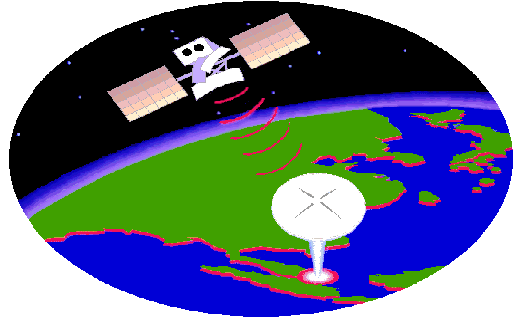
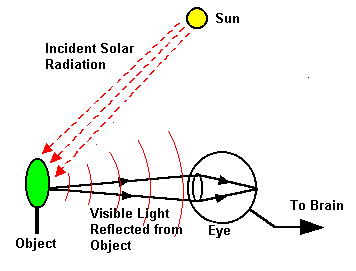

We perceive the surrounding world through our five senses. Some senses (touch
and taste) require contact of our sensing organs with the objects. However,
we acquire much information about our surrounding through the senses of
sight and hearing which do not require close contact between the sensing
organs and the external objects. In another word, we are performing Remote
Sensing all the time.
Generally, Remote sensing refers to the activities of recording/observing/perceiving
(sensing) objects or events at far away (remote) places.
In remote sensing, the sensors are not in direct contact with the
objects or events being observed.  The information needs a physical carrier to travel from the objects/events
to the sensors through an intervening medium. The electromagnetic
radiation is normally used as an information carrier in remote
sensing. The output of a remote sensing system is usually an image
representing the scene being observed. A further step of image
analysis and interpretation is required in order to extract useful
information from the image. The human visual system
is an example of a remote sensing system in this general sense.
The information needs a physical carrier to travel from the objects/events
to the sensors through an intervening medium. The electromagnetic
radiation is normally used as an information carrier in remote
sensing. The output of a remote sensing system is usually an image
representing the scene being observed. A further step of image
analysis and interpretation is required in order to extract useful
information from the image. The human visual system
is an example of a remote sensing system in this general sense.
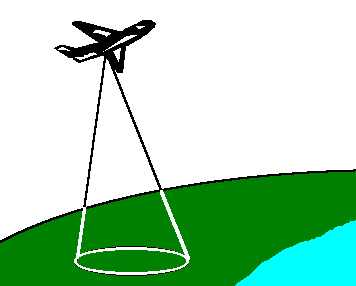 In a more restricted sense, remote sensing usually refers to the
technology of acquiring information about the
earth's surface (land and ocean) and atmosphere using sensors onboard airborne
(aircraft, balloons) or spaceborne
(satellites, space shuttles) platforms.
In a more restricted sense, remote sensing usually refers to the
technology of acquiring information about the
earth's surface (land and ocean) and atmosphere using sensors onboard airborne
(aircraft, balloons) or spaceborne
(satellites, space shuttles) platforms.
|
Satellite Remote Sensing
 In this CD, you will see many remote sensing images around Asia acquired
by earth observation satellites. These remote
sensing satellites are equipped with sensors looking down to the
earth. They are the "eyes in the sky" constantly observing the
earth as they go round in predictable orbits.
In this CD, you will see many remote sensing images around Asia acquired
by earth observation satellites. These remote
sensing satellites are equipped with sensors looking down to the
earth. They are the "eyes in the sky" constantly observing the
earth as they go round in predictable orbits.
|
Effects of Atmosphere

In satellite remote sensing of the earth, the sensors are looking through a
layer of atmosphere separating the sensors
from the Earth's surface being observed. Hence, it is essential to understand
the effects of atmosphere on the electromagnetic radiation travelling
from the Earth to the sensor through the atmosphere. The atmospheric
constituents cause wavelength dependent absorption
and scattering of radiation. These effects
degrade the quality of images. Some of the atmospheric effects can be
corrected before the images are subjected to further analysis and interpretation.
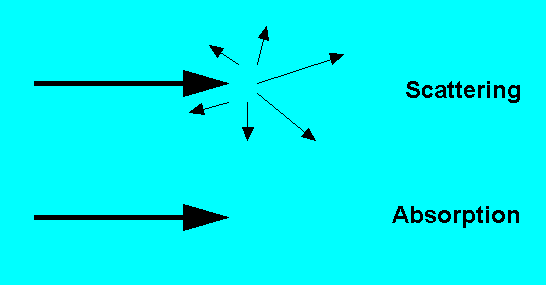 A consequence of atmospheric absorption is that certain
wavelength bands in the electromagnetic spectrum are strongly absorbed
and effectively blocked by the atmosphere. The wavelength regions in the
electromagnetic spectrum usable for remote sensing are determined by their
ability to penetrate atmosphere. These regions are known as the atmospheric
transmission windows. Remote sensing systems are often designed
to operate within one or more of the atmospheric windows. These windows
exist in the microwave region, some wavelength bands in the infrared,
the entire visible region and part of the near ultraviolet regions. Although
the atmosphere is practically transparent to x-rays and gamma rays, these
radiations are not normally used in remote sensing of the earth. A consequence of atmospheric absorption is that certain
wavelength bands in the electromagnetic spectrum are strongly absorbed
and effectively blocked by the atmosphere. The wavelength regions in the
electromagnetic spectrum usable for remote sensing are determined by their
ability to penetrate atmosphere. These regions are known as the atmospheric
transmission windows. Remote sensing systems are often designed
to operate within one or more of the atmospheric windows. These windows
exist in the microwave region, some wavelength bands in the infrared,
the entire visible region and part of the near ultraviolet regions. Although
the atmosphere is practically transparent to x-rays and gamma rays, these
radiations are not normally used in remote sensing of the earth.
|
Optical and Infrared Remote Sensing
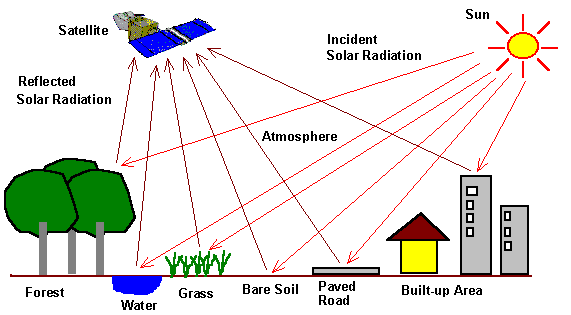 In Optical Remote Sensing, optical sensors
detect solar radiation
reflected or scattered from the earth, forming images resembling photographs
taken by a camera high up in space. The wavelength region usually extends
from the visible and near infrared
(commonly abbreviated as VNIR) to the short-wave infrared
(SWIR).
In Optical Remote Sensing, optical sensors
detect solar radiation
reflected or scattered from the earth, forming images resembling photographs
taken by a camera high up in space. The wavelength region usually extends
from the visible and near infrared
(commonly abbreviated as VNIR) to the short-wave infrared
(SWIR).
|
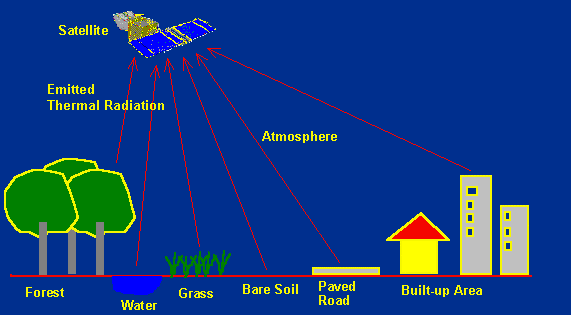
Different materials such as water, soil, vegetation, buildings and roads reflect
visible and infrared light in different ways. They have different colours
and brightness when seen under the sun. The interpretation
of optical images require the knowledge of the spectral
reflectance signatures of the various materials (natural or man-made)
covering the surface of the earth.
|
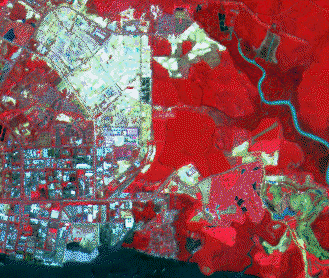
There are also infrared sensors measuring the thermal infrared radiation
emitted from the earth, from which the land or sea surface temperature
can be derived.
|
Microwave Remote Sensing
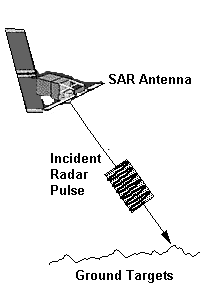 There are some remote sensing satellites which carry passive or active microwave
sensors. The active sensors emit pulses of microwave
radiation to illuminate the areas to be imaged. Images of the earth
surface are formed by measuring the microwave energy scattered by the ground
or sea back to the sensors. These satellites carry their own "flashlight"
emitting microwaves to illuminate their targets. The images can thus be
acquired day and night. Microwaves have an additional advantage as they
can penetrate clouds. Images can be acquired even when there are clouds
covering the earth surface.
There are some remote sensing satellites which carry passive or active microwave
sensors. The active sensors emit pulses of microwave
radiation to illuminate the areas to be imaged. Images of the earth
surface are formed by measuring the microwave energy scattered by the ground
or sea back to the sensors. These satellites carry their own "flashlight"
emitting microwaves to illuminate their targets. The images can thus be
acquired day and night. Microwaves have an additional advantage as they
can penetrate clouds. Images can be acquired even when there are clouds
covering the earth surface.
 A microwave imaging system which can produce high resolution image of the Earth is the synthetic aperture radar (SAR).
The intensity in a SAR image depends on the amount of microwave backscattered by the target and received by the SAR antenna. Since the physical mechanisms responsible for this backscatter is different for microwave, compared to visible/infrared radiation, the interpretation of SAR images requires the knowledge of how microwaves interact with the targets.
A microwave imaging system which can produce high resolution image of the Earth is the synthetic aperture radar (SAR).
The intensity in a SAR image depends on the amount of microwave backscattered by the target and received by the SAR antenna. Since the physical mechanisms responsible for this backscatter is different for microwave, compared to visible/infrared radiation, the interpretation of SAR images requires the knowledge of how microwaves interact with the targets.
|
Remote Sensing Images
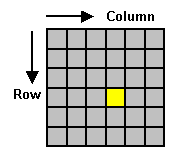
 Remote sensing images are normally in the form of digital
images. In order to extract useful information from the images,
image processing techniques may be employed
to enhance the image to help visual interpretation, and to correct
or restore the image if the image has been subjected to geometric
distortion, blurring or degradation by other factors. There are many image
analysis techniques available and the methods used depend on the requirements
of the specific problem concerned. In many cases, image segmentation
and classification algorithms are used to delineate different areas
in an image into thematic classes. The resulting product is a thematic
map of the study area. This thematic map can be combined with other
databases of the test area for further analysis and utilization.
Remote sensing images are normally in the form of digital
images. In order to extract useful information from the images,
image processing techniques may be employed
to enhance the image to help visual interpretation, and to correct
or restore the image if the image has been subjected to geometric
distortion, blurring or degradation by other factors. There are many image
analysis techniques available and the methods used depend on the requirements
of the specific problem concerned. In many cases, image segmentation
and classification algorithms are used to delineate different areas
in an image into thematic classes. The resulting product is a thematic
map of the study area. This thematic map can be combined with other
databases of the test area for further analysis and utilization. |
 Visual System Visual System
 Go to Main Index Go to Main Index
|
|


 What is Remote Sensing?
What is Remote Sensing? 
 Visual System
Visual System
 Go to Main Index
Go to Main Index
 What is Remote Sensing?
What is Remote Sensing?